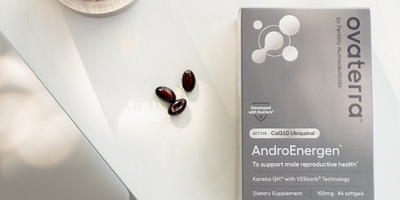Are you planning to start a family? On your TTC journey, you may be looking for a natural family planning method to pinpoint when you should actively try to get pregnant.
One way to track your most fertile days is to use the basal body temperature or the BBT method. When using this method, you will need a particular type of thermometer to measure and track your body’s temperature throughout your cycle. This thermometer is called a basal body thermometer.
Let’s dig deeper into how to use a basal body thermometer to support your chances of fertility.
What is a basal body thermometer?
A basal body thermometer is a tool to help predict your most fertile days during your menstrual cycle. You can choose between many different thermometers on the market. Some may have more benefits, like an app to help you chart and track your basal body temperature daily during your cycle.
Different types of basal body thermometers
- Digital basal thermometer: These have a small digital display, much like a typical thermometer you would find at a drug store.
- Glass thermometer: This is a traditional, battery-free way to check your temperature.
- Smart thermometer: These thermometers use an app to help keep track of your basal body temperature.
- Tempdrop basal body temperature monitor: This armband temperature monitor keeps track of your core body temperature as you sleep each night. It includes an app and uses a predictive algorithm to identify your fertile window, based on your unique BBT patterns.
How is a basal body thermometer different from a regular thermometer?
Like a regular thermometer, a basal body thermometer takes your body’s temperature. However, basal body thermometers measure in smaller increments, some measuring 1/100 of a degree.
If you are using this tool as a way to help you conceive, you want a thermometer with the most accurate reading possible to ensure your chances of success. The temperature changes that signal ovulation can be just 1/10 of a degree, so you’d want a BBT thermometer that can pick up these small changes.
What is a basal body thermometer used for?
A basal body thermometer is used for tracking your basal body temperature to support your chances of conception. When using this method to track your ovulation, you will need to take your temperature every morning during a few menstrual cycles to understand your body’s pattern and predict when you are most likely to get pregnant.
Not everyone’s body runs at the same temperature before or during ovulation, so it is important to take the time to track your pattern accurately. It may take a few cycles before you can recognize a pattern.
How does a basal body thermometer hint at ovulation?
Your BBT is the temperature of your body when you are at a complete resting state. During ovulation, many women may experience a slight increase in their basal body temperature, preceded by a slight dip. This increase in BBT is driven by the increase in progesterone levels in the luteal phase (the second half of your menstrual cycle after ovulation).
This increase can be as little as a tenth of a degree to over one. Typically your basal body temperature will be between 97 and 98 degrees Fahrenheit. During ovulation, some women may notice their temperature rise from 97.6°F to 98.6°F. Using a BBT thermometer can detect these small changes - and you know when you are ovulating.
A few days before your temperature rises is when your body will be the most fertile. The thermometer will help track your ovulation days and pinpoint when your “fertile window” opens.
Your body is the most fertile four to five days before ovulation and 12 to 24 hours after the egg has been released. If you have intercourse a few days before the rise in your BBT, sperm may be waiting in the fallopian tube when the egg is released, thus increasing your chance of conception.
Note: Sperm can live up to five days in the female reproductive tract, waiting for an egg to fertilize, while an egg only lives for 12 to 24 hours after it leaves the ovarian follicle.
What are the pros of using a basal body thermometer?
Using a basal body temperature thermometer is an easy and mess-free way to track your ovulation. Using a BBT thermometer can be lower cost than other methods of ovulation tracking, like ovulation test strips that you have to purchase every month.
What are the cons of using a basal body thermometer?
When using a BBT thermometer alone, you may not be able to always predict ovulation accurately because there are many factors that make your temperature rise or fall. For example, a cold or an infection can raise your BBT; even stress can cause a temperature change.
Many other factors can cause temperature fluctuations, which may make using a BBT thermometer less accurate than some other methods. One solution is to use a smart BBT thermometer like Tempdrop, which uses an algorithm to remove the noises and detect the pattern.
Other methods to use with a BBT thermometer
Combining different methods of tracking ovulation may increase your chances of getting pregnant. Here are a couple of methods you can use with the BBT method:
- Cervical mucus tracking: Before, during, and after ovulation, you may experience changes in your cervical mucus. Just before ovulation, your vaginal mucus will have the consistency of egg whites. After ovulation, your mucus will thicken and become cloudy. If you notice an egg-white texture before your temperature changes, you may be in the fertile days of your menstrual cycle.
- Ovulation test strips: These strips are urine tests that detect hormone levels, like progesterone and luteinizing hormone, in your urine. Your luteinizing hormone increases days before ovulation. This is a way for your body to trigger the mature egg to be released. If you notice an increase in body temperature and a positive result from a test strip, it’s likely you are about to ovulate or have already ovulated.
Why should you track your basal body temperature?
Did you know that 85 percent of women using fertility awareness methods have difficulty identifying their fertile window? Tracking your basal body temperature is an easy, low-cost way to increase the accuracy of your fertile window identification and support your chances of becoming pregnant - worth adding to your fertility toolbox, especially if you have been trying without success.
How can you use your BBT chart to predict ovulation?
If you get a modern BBT thermometer with an app, it will likely include a basal body temperature chart. You can use the BBT chart to view your results and identify when your temperature rise happens, sometime in the middle of your menstrual cycle.
Tip: Make sure you are taking your BBT at the same time each day. In most cases, you should measure your BBT in the morning, just after you wake up and before you do anything else.
How do you schedule sex using a BBT chart?
Timing is everything. When using an accurate basal body temperature chart for a few cycles, you can predict when your fertile window is. To maximize your chance of pregnancy, you will want to have sex, starting a few days before your expected ovulation up to the day of ovulation.
Can anything else affect your BBT?
Yes, many things can affect your basal body temperature. Here is a non-exhaustive list of things that may affect your BBT:
- Alcohol consumption
- Infections
- Stress
- Medications
- Traveling from different time zones
- Breastfeeding
Does basal body temperature ever fall if you aren’t pregnant?
Yes. Typically, your BBT will come down about 10 to 14 days after ovulation if a pregnancy didn't take place.
What should you know before you buy a basal body thermometer?
- You will have to wake up at the same time each day to get accurate readings. (Or use Tempdrop, which monitors your temperature throughout the night so you don’t have to worry about taking your temperature every morning.)
- Do your research and get a quality BBT thermometer that can measure at least down to 1/10 of a degree.
- You may want to use a basal body thermometer and methods like cervical mucus tracking for best results.
The bottom line
Using a BBT thermometer to track your most fertile days can help support your journey. An app is not absolutely necessary, but visualizing the BBT pattern and seeing the pattern with day-to-day fluctuations smoothed out can be helpful. To get the most accurate results, you want to choose a quality thermometer that provides you with an app to chart your results.
Using other methods with the BBT thermometer can better your chances of success. Check out other posts in our Resource Library to learn more about making the most of your reproductive life - and please reach out if we can answer any questions. We are with you.













